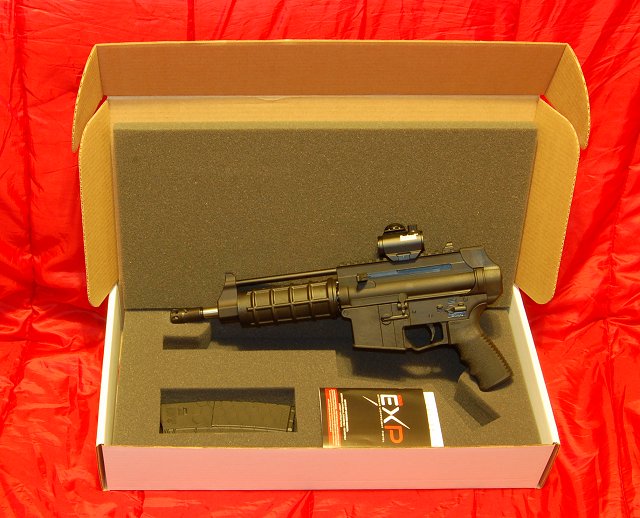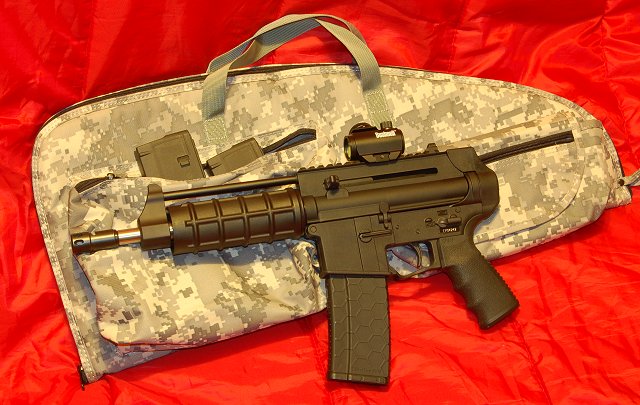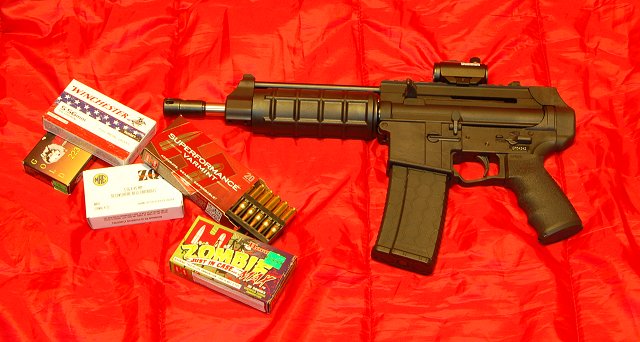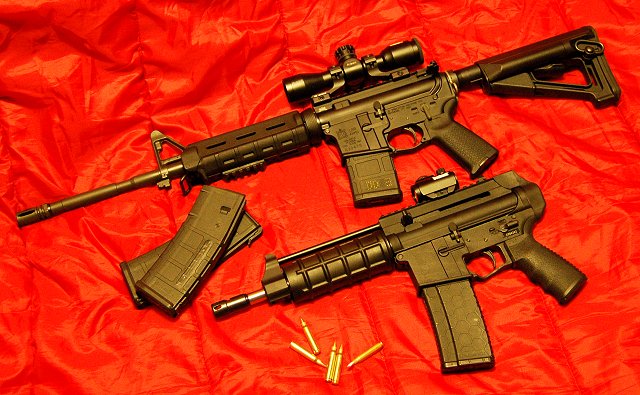BTW.... I want a BATF approved AR pistol .... bored with Air Pistols
TC





xl_target wrote:The problem with Southern Minnesota is that it is basically prairie and there are maybe a few fence posts to break the winds as they come howling in from the wastelands of the Dakotas.
There are all kinds of miracle synthetic materials and insulations. They are good, but they don't breath like natural stuff does and they make a great racket when moving through the woods. I've worn my Filson coat in Ottawa Canada at Christmas time, and for Chicago or Minnesota, where it's windy, I want a good quality leather coat with insulation. The one I have now has a zip-in knit collar that will seal my neck and the buttoned opening quite well -- it's pretty good. I find that synthetics that will block the wind won't let the body breath, and it's too easy to work up a sweat in them. Once you sweat, you are wet and all is lost as far as keeping warm.xl_target wrote:You can dress warm but once the wind starts, it will cut through the your outer wear like it isn't even there.
One winter, my Brother drove me out on Lake Minnetonka. Those crazy Scandahoovians were out on the ice as if it was a park in summer. They played volleyball, sat on sofas and watched big screen TVs powered by generators, ran 4-wheelers all over and carried on having all sorts of fun. I couldn't get over it!xl_target wrote:Of course, there are the winter sports enthusiasts, who delight in skiing, sledding, snowboarding and snowmobiling. Some of the modern snowmobiles are capable of doing 120 mph with ease. Snomobilers dress up like spacemen, complete with insulated helmets.
Here, Montana was different. The ice did not melt at all during the day, and the sand poured out on the roads soon became like pavement. Car exhaust evaporated immediately in the dry cold air. The roads were generally pretty good, unless it was fall or spring, when they would thaw and refreeze at night.xl_target wrote:Snow on the roads, if not cleared right away, will get packed down and turn into ice. Driving on that is like driving on a skating rink. You also get ice from the water vapor in automobile exhaust. It freezes and coats the roads forming a thin layer of ice. You won't know that it is there till you touch the brakes or try a lane change.
Eastern New Mexico, east of Albuquerque: I once drove from Edgewood to Moriarty in my pickup. It was, as they say, slicker than snot and the wind was really gusting, as it always did and does there. The wind gusted so strong that it blew my pickup about a foot over the road -- my rear tires were chained up! That is bodacious wind!xl_target wrote:Then you have the gusting winds that push your vehicle around.
I find that the biggest threat is people who don't know how to drive. Exactly as XL says, everything must be planned ahead of time, and light touches on the throttle, brakes, and steering are a must. The problem comes in when some fool thinks he can pull out in front of you because you have left a larger than normal gap. Then there are the people who won't or can't by good tires and drive around with baldies. They are huge hazards to deal with.xl_target wrote:After a while you learn how to drive for the conditions here. You have no choice as you have to go to work every day. I've had my share of winter driving mishaps and for the most part, I know what I am doing now. Steering and brake inputs have to be very gradual and speeds have to be kept down relative to the road conditions. Good tires are extremely important and you have to keep large distances between you and them when following other vehicles.
Exactly so! The only problem, though, is that common sense isn't always so common!xl_target wrote:You just have to use common sense for the most part.



XL.... August is my most favourite month from todayxl_target wrote:TC,
You will feel right at home during August.
Minnesota is pretty near tropical at that time.



[quote=""timmy"]I can see how this would work, although it's surprising that so little volume under so much pressure would make so great a difference. I confess, one of these does look inviting. Thanks for your patience and explaining!
[/quote]xl_target wrote:Dammit Timmy,
I read your statement and thought; "hmmm, why not".
SInce you asked that question about the pigtailed gas tube, I've spent a lot of time on research and have decided that I want an AR15 pistol.




The patent is HEREThe most widely used method of operation of automatic rifles today is the conventional gas cylinder, piston and actuating rod assembly; the only other system now in production use being the recoil actuating system. The blow-back or inertia block system is usually reserved for weapons using lower powered ammunition, such as pistol and .22 caliber weapons.
It is a principal object of this invention to utilize the basic parts of an automatic rifle mechanism such as the bolt and bolt carrier to perform a double function. This double function consists of the bolts primary function to lock the breach against the pressure of firing, and secondarily, to act as a stationary piston to actuate the automatic rifle mechanism. The primary function of the bolt carrier is to lock and unlock the bolt by rotating it and to carry it back and forth in the receiver. The secondary function of the bolt carrier is to act as a movable cylinder to actuate the automatic rifle mechanism. By having the bolt carrier act as a movable cylinder and the bolt act as a stationary piston, the need for a conventional gas cylinder, piston and actuating rod assembly is eliminated.
It is an object of this invention to provide a gas system which is lighter and less expensive to produce because of its simplicity than the present gas systems now used in automatic rifle mechanisms.
It is another object of this invention to utilize the energy of the expanding gas developed by the firing of the weapon, for actuating the automatic rifle mechanism directly by use of a metered amount of the gas coming from the barrel. This invention is a true expanding gas system instead of the conventional impinging gas system. By utilization of a metered amount of gas from the barrel, the automatic rifle mechanism is less sensitive to different firing pressures caused by variations in the propelling charge. It is therefore still another object of this invention, to provide a rifle mechanism which is not affected by variations in the propelling charge.
A further object of this invention is to provide smoother operation and longer life of the working parts of the automatic rifle mechanism. Since, in this invention, the actuating force is transmitted directly down the center line of the barrel and the bolt mechanism to the shoulder of the shooter, all of the off center loads found in most other types of gas actuated Weapons are eliminated. It will therefore be obvious because of this factor that another object of this invention is to cut down on climb which occurs during automatic firing operations.
Tim, lets look at Olympic Arms 1995 patent on a semi automatic pistol. That will give you your answer.timmy wrote:What I can't figure is, what did they do with the recoil spring and tube? That Carbon 16 that I always liked still had the tube extendong backwards.
Patent available HEREThe present invention overcomes the disadvantages of the above-described firearms by providing a modified M16 pistol design that utilizes standard rifle cartridges such as the 5.56 mm NATO (.223 Rem.) caliber without need for an extended buffer chamber at the rear of the pistol. The present invention achieves its advantages by providing a modified M16 pistol which utilizes a shortened M16 bolt assembly and a spring-biased buffer system mounted in the upper portion of the receiver, above the bolt assembly.





